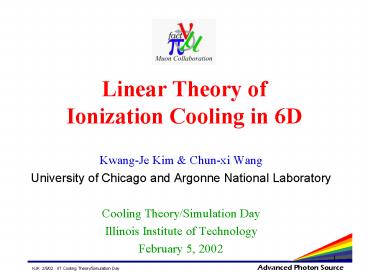Linear Theory of Ionization Cooling in 6D - PowerPoint PPT Presentation
Title:
Linear Theory of Ionization Cooling in 6D
Description:
KJK 2/5/02 IIT Cooling Theory/Simulation Day Advanced Photon Source ... Solenoidal focusing and angular momentum. Emittance exchange ... – PowerPoint PPT presentation
Number of Views:49
Avg rating:3.0/5.0
Title: Linear Theory of Ionization Cooling in 6D
1
Linear Theory of Ionization Cooling in 6D
- Kwang-Je Kim Chun-xi Wang
- University of Chicago and Argonne National
Laboratory - Cooling Theory/Simulation Day
- Illinois Institute of Technology
- February 5, 2002
2
- Theory development . . . . . . . . . . . . . . .
. . . . Kwang-Je Kim - Examples and asymmetric beams . . . . . . . .
Chun-xi Wang
3
Ionization Cooling Theory in Linear Approximation
- Similar in principle to radiation damping in
electron storage rings, but needs to take into
account - Solenoidal focusing and angular momentum
- Emittance exchange
- Slow evolution near equilibrium can be described
by five Hamiltonian invariants
4
Equation of Motion
- Phase space vector
5
Emittance Exchange
6
Hamiltonian Under Consideration
Solenoid dipole quadrupole RF absorber
Goal theoretical framework and possible solution
solenoid
dipole
quadrupole
r.f.
,
7
Equations for Dispersion Functions
In Larmor frame
Dispersion function decouples the betatron motion
and dispersive effect
8
Coordinate Transformation
- Rotating (Larmor) frame
- Decouple the transverse and longitudinal motion
via dispersion - x xb Dxd, Px Pxb Dx?d
- Dispersion vanishes at rf
9
Wedge Absorbers
qw
10
Natural ionization energy loss is insufficient
for longitudinal cooling
Transverse cooling
slope is too gentle for effective
longitudinal cooling
Will be neglected
11
Model for Ionization Processin Larmor Frame
- Transverse
- Longitudinal
?
M.S.
straggling
Average loss replenished by RF
12
Equation for 6-D Phase Space Variables
- x x? ? Dx, Px Px? ?
- z z? -
- Dispersion vanishes at cavities
- Drop suffix ?
13
Equilibrium Distribution
- Linear stochastic equation ? Gaussian
distribution - For weak dissipation, the equilibrium
distribution evolves approximately as Hamiltonian
system. - ? I is a quadratic invariant with periodic
coefficients.
14
Quadratic Invariants
- Three Courant-Snyder invariants
- (?, ?, ?), (?z, ?z , ?z) Twist
parameters for ? and - Two more invariants when ?x ?y
- These are complete set!
15
Beam Invariants, Distribution,and Moments
- Beam invariants (emittances)
- Distribution
16
Beam Invariants, Distribution, and Moments
(contd.)
- Non-vanishing moments
- These are the inverses of Eq. (a).
(b)
17
Evolution Near Equilibrium
- ?i are slowly varying functions of s.
- Insert
- Use Eq. (b) to convert to emittances.
18
Evolution Near Equilibrium (contd.)
- Diffusive part straggling ?? and multiple
scattering ?. - x(sDs) x(s)-Dx?d.
- Px(sDs) Px(s)-Dx????
- lt ?dgt lt ?gt 0
- lt ?d2gt ?dDs, lt ?2gt ? Ds, lt?d ?gt 0
19
Emittance Evolution Near Equilibrium
- ??s -(?-ec-) ?sec?aes?xyb?L?s,
- ??a -(?-ec-) ?aec?s ?a,
- ??xy -(?-ec-) ?xyes?s ?xy,
- ??L -(?-ec-) ?Lb?s ?L,
- ??z -(???2ec-) ?z ?z,
- C cos(qD-qw), s sin(qD qw), s-? sin
(qD?-qw) - b ?xb aes- be?s-?
20
The Excitations
21
Remarks
- Reproduces the straight channel results for D
0. - Damping of the longitudinal emittance at the
expense of the transverse damping. - 6-D phase spare area
- Robinsons Theorem
- Numerical examples and comparison with
simulations are in progress.













![Lecture note : Gas chromatography [2] ????????? ??? PowerPoint PPT Presentation](https://s3.amazonaws.com/images.powershow.com/6741367.th0.jpg?_=20150612015)

















